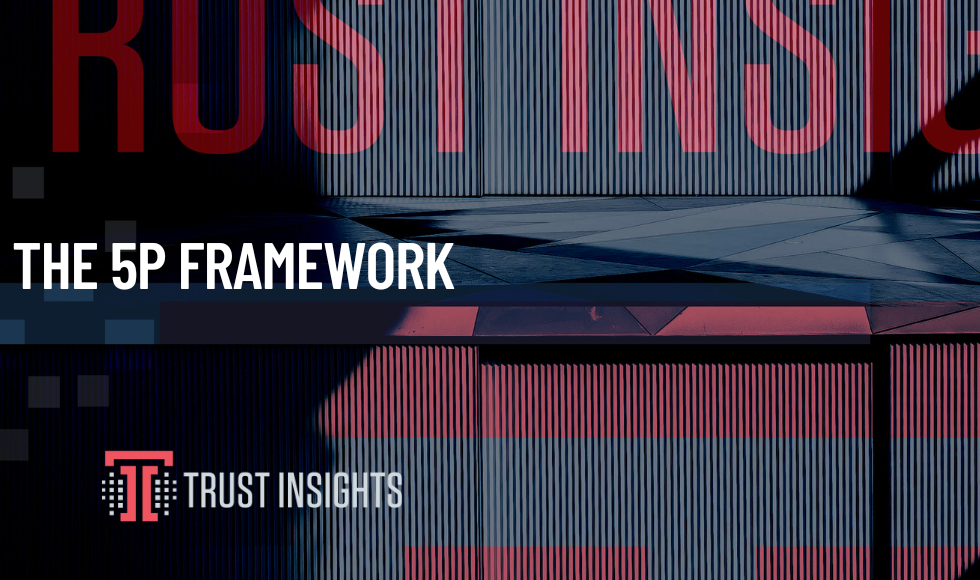This data was originally featured in the March 27th, 2024 newsletter found here: INBOX INSIGHTS, MARCH 27, 2024: THE 5P FRAMEWORK, AI CONTENT GAP ANALYSIS
THE 5P FRAMEWORK – WHERE IT BEGAN
Last week I had the realization that a lot of us come to – just because I know something well doesn’t mean everyone else does. I’ve been making assumptions about how well “everyone” else knows the 5P Framework. To give myself a gut check, I put up a quick poll on LinkedIn and got a few “I don’t know what the 5P Framework is” responses.
Knowing this is super helpful. I ended up writing this piece and pinning it to my profile.
The 5Ps are Purpose, People, Process, Platform, and Performance.
- Purpose – What is the question we’re trying to answer? What is the problem we’re trying to solve.
- People – Who should you involve? Who needs to know about this?
- Process – How will we answer this question, solve this problem?
- Platform – What tools do we need? What software will we use?
- Performance – How will we measure success? How do we know we solved the problem?
I created the 5P Framework as a reaction to digital transformation. Digital Transformation is “People, Process, Technology” with an emphasis on technology. I’ve been working long enough to have been through quite a few “transformations”. To put it in perspective, when I started working with developers our technology was floppy disks and CD-ROM. Bringing our product “online” was a huge and painful step.
We struggled through this transition. The technology wasn’t the problem, it was a natural step. The problem was with the approach. It was the people and the processes. We made the naive assumption that the user workflow would be the same online as it was from a CD-Rom. Spoiler – it wasn’t. The web offered us new functionality not previously possible with the older technology. Instead of taking a step back to examine our decisions, we just kept developing and innovating. We lost sight of the end user and became too focused on the final product.
This is just one of many examples. There are times when a digital transformation effort goes well, but in those cases it’s not usually referred to a digital transformation. The phrase puts the wrong expectations on an initiative and creates a bias of “tech” first.
The consulting firm Capgemini, (in partnership with the MIT), coined the term “digital transformation” in 2011. They defined the phrase as: “the use of technology to radically improve performance or the reach of businesses.” (source)
Here’s the problem. In theory, it makes sense. Your business needs to continue to evolve as tech changes. Your customers will expect it and your teams will be itching to skill up. In practice, it is technology first. When we choose a platform first, we have to retrofit our processes and people into it. There may be mismatches and lack of features. However, we’ve purchased or subscribed to the tech, so we feel obligated to make it work. It can be a burden on the company financially and burn out your teams to try to make it work.
When I talk about the 5P Framework, I often tell the story of how I tried to roll out MS Project with Sharepoint three different times at my old job. The technology was fine enough, but the company chose it without consideration of the people and processes. Looking back, it wasn’t the right solution. Since it was the technology they chose, they were determined to make it work. They were determined to have me make it work. It was a lot of time and energy put into an initiative that wasn’t set up for success.
This is why I created the 5P Framework. It puts people and processes first. It is also bookended by purpose and performance. I’m that annoying team member who always asks, “Why?”. It’s kind of like trying to fend off a toddler. I will keep asking “why” until I get a satisfactory answer. And then I will remember what you told me and want to know if that was the result. I know I’m not alone in this, I just happen to be painfully self aware.
If you are wanting to evolve your business with a digital transformation, know that it is a culture shift. It’s more than a transformation. It’s an overhaul. And it is not a small effort. You want to be clear on your purpose. You need to get your people on board. You need to understand how your processes will change. Then you can choose your platform. Lastly, you want to measure your performance.
Have you been through a digital transformation? I want to hear your story! Reply to this email to tell me or come join the conversation in our Free Slack Group, Analytics for Marketers.
– Katie Robbert, CEO






